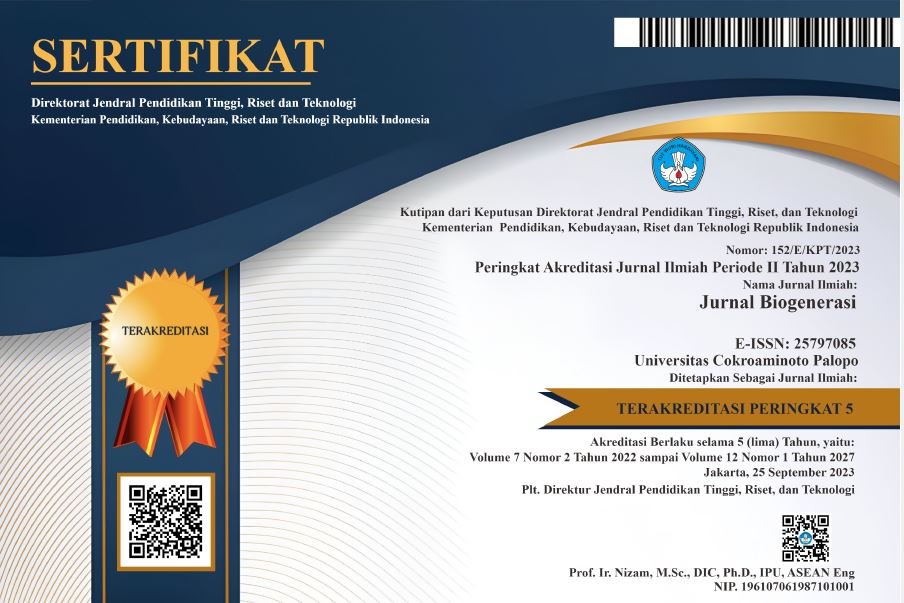LITERATURE REVIEW : ANALISIS KETERAMPILAN BERPIKIR KRITIS PESERTA DIDIK
DOI:
https://doi.org/10.30605/biogenerasi.v10i2.5772Keywords:
Critical thinking skills, students, literature review, HOTSAbstract
Critical thinking skills are one of the essential competencies of the 21st century that students must possess to face the challenges of the times. This study aims to analyze the level of students' critical thinking skills through a literature review of five relevant articles across different educational levels. The method used is a literature review with purposive sampling, where articles are selected based on the alignment of themes and pre-determined criteria. The analysis results show that, in general, students' critical thinking skills are still in the low to moderate category. Contributing factors include difficulties in understanding questions, lack of HOTS-based exercises, the influence of the learning environment, and limited habits of analyzing information. Therefore, joint efforts from teachers, schools, and students are required to enhance these skills through active, innovative, and problem-solving-based learning.
Downloads
References
Irawan, T. A., Rahardjo, S. B., & Sarwanto, S. (2017). Analisis kemampuan berpikir kritis siswa kelas VII-A SMP Negeri 1 Jaten. In Prosiding SNPS (Seminar Nasional Pendidikan Sains) (pp. 232-236).
Agustine, J., Nizkon, N., & Nawawi, S. (2020). Analisis keterampilan berpikir kritis peserta didik SMA kelas X IPA pada materi virus. Assimilation: Indonesian Journal of Biology Education, 3(1), 7–11. https://doi.org/10.17509/aijbe.v3i1.23297
Ariza Rahmadana Hidayati, Wirawan Fadly, & Rahmi Faradisya Ekapti. (2021). Analisis Keterampilan Berpikir Kritis Siswa pada Pembelajaran IPA Materi Bioteknologi. Jurnal Tadris IPA Indonesia, 1(1), 34–48. https://doi.org/10.21154/jtii.v1i1.68
Costa, A. L. (1985). Developing Minds: A resource bookfor teaching thinking. Association for Curriuclum and Supervision. Arlington, VA.
Eviota, J. S., & Liangco, M. M. (2020). Jurnal Pendidikan MIPA. Jurnal Pendidikan, 14(September), 723–731.
Fithriyah, I., Sa’dijah, C., & Sisworo. (2016). Analisis kemampuan berpikir kritis siswa kelas IX-D SMPN 17 Malang. Konferensi Nasional Penelitian Matematika Dan Pembelajarannya, Knpmp I, 580–590.
Irawan, T. A., Rahardjo, S. B., & Sarwanto, S. (2017). Analisis kemampuan berpikir kritis siswa kelas VII-A SMP Negeri 1 Jaten. In Prosiding SNPS (Seminar Nasional Pendidikan Sains) (pp. 232-236).
Joyce, B., & Calhoun, E. (2014). The 21st-Century Skills. Realizing the Promise of 21st-Century Education: An Owner’s Manual, 46–66. https://doi.org/10.4135/9781483387451.n6
Kartimi. (2012). Pengembangan Alat Ukur Berpikir Kritis pada Konsep Termokimia untuk Siswa SMA. Jurnal Scientiae Educatia, 1(1), 1–14.
Makassar, S., & Sarip, N. (2022). ANALISIS KETERAMPILAN BERPIKIR KRITIS PESERTA DIDIK KELAS X DI tidak sesuai kebenarannya ( hoax ). Salah satu upaya yang dilakukan lembaga pendidikan untuk berpikir kritis ( Critical Thinking Skill ). Keterampilan berpikir kritis sangat penting dimiliki o. Jurnal Sains Dan Pendidikan Fisika (JSPF), 18(3), 291–299. http://ojs.unm.ac.id/jsdpf
Sarip, N., Kaharuddin, K., & Palloan, P. (2022). Analisis Keterampilan Berpikir Kritis Peserta Didik Kelas X Di Sman 10 Makassar. Jurnal Sains Dan Pendidikan Fisika, 18(3), 291. https://doi.org/10.35580/jspf.v18i3.31668
Solikhin, M., Seno, A. A., & Utami, B. (2024). Analisis Kemampuan Berpikir Kritis Peserta Didik sebagai Evaluasi Pembelajaran IPA di SMP Bina Insan Mandiri. SINKESJAR : Seminar Nasional Sains, Kesehatan, Dan Pembelajaran, 465–472.
Umbara, H. D. A. D., & Priatna, N. (2022). Analisis Kemampuan Berpikir Kritis Matematis Siswa Ditinjau Dari Self-Confidence. Sigma, 8(1), 48. https://doi.org/10.53712/sigma.v8i1.1690
Wibowo, W. S., Roektiningroem, E., Bastian, N., & Hudda, K. S. (2018). Development of Project-Based Learning Science Module to Improve Critical Thinking Skills of Junior High School Students. Journal of Science Education Research, 2(2), 71–76. https://doi.org/10.21831/jser.v2i2.22471
Zulkarnaen, R. (2018). Implementasi Interpretation-Construction Design Model Terhadap Kemampuan Pemodelan Matematis Siswa SMA. Jurnal Pendidikan Matematika, 18(1), 25–32.
Downloads
Published
How to Cite
Issue
Section
License
In submitting the manuscript to the journal, the authors certify that:
- They are authorized by their co-authors to enter into these arrangements.
- The work described has not been formally published before, except in the form of an abstract or as part of a published lecture, review, thesis, or overlay journal.
- That it is not under consideration for publication elsewhere,
- That its publication has been approved by all the author(s) and by the responsible authorities – tacitly or explicitly – of the institutes where the work has been carried out.
- They secure the right to reproduce any material that has already been published or copyrighted elsewhere.
- They agree to the following license and copyright agreement.
License and Copyright Agreement
Authors who publish with this journal agree to the following terms:
- Authors retain copyright and grant the journal right of first publication with the work simultaneously licensed under Creative Commons Attribution License (CC BY 4.0) that allows others to share the work with an acknowledgment of the work's authorship and initial publication in this journal.
- Authors are able to enter into separate, additional contractual arrangements for the non-exclusive distribution of the journal's published version of the work (e.g., post it to an institutional repository or publish it in a book), with an acknowledgment of its initial publication in this journal.
- Authors are permitted and encouraged to post their work online (e.g., in institutional repositories or on their website) prior to and during the submission process, as it can lead to productive exchanges, as well as earlier and greater citation of published work.


.png)

